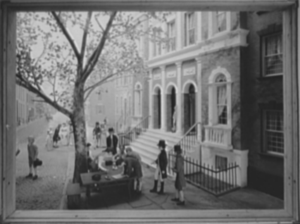Buttonwood Agreement

The Buttonwood Agreement, which took place on May 17, 1792, was an effort to organize securities trading in New York City that preceded the formation of the New York Stock & Exchange Board now called the New York Stock Exchange. This agreement was signed by 24 stockbrokers outside of 68 Wall Street. According to legend the signing took place under a buttonwood tree, but this tree may never have existed.[1]
Document agreement
In brief, the agreement had two provisions: 1) the brokers were to deal only with each other, thereby eliminating the auctioneers, and 2) the commissions were to be 0.25%. It reads as follows:
We the Subscribers, Brokers for the Purchase and Sale of the Public Stock, do hereby solemnly swear and pledge ourselves to each other, that we will not buy or sell from this day for any person whatsoever, any kind of Public Stock, at a less rate than one quarter percent Commission on the Specie value and that we will give preference to each other in our Negotiations. In Testimony whereof we have set our hands this 17th day of May at New York, 1792.[2]
Source Document
The document is part of the archival collection of the New York Stock Exchange.[3] The Virtual Museum and Archive of the History of Financial Regulation of The Securities and Exchange Commission Historical Society does have this image.
Names and address
The twenty-four brokers (also known as, Founding and Subsequent Fathers) who signed the Buttonwood Agreement were (including business location):[4]
- Peter Anspach … 3 Great Dock Street
- Armstrong & Barnewall … 58 Broad Street
- Andrew D. Barclay … 136 Pearl Street
- Samuel Beebe … 21 Nassau Street
- G. N. Bleecker … 21 Broad Street
- Leonard Bleecker … 16 Wall Street
- John Bush … 195 Water Street
- John Ferrers … 205 Water Street
- Isaac M. Gomez … 32 Maiden Lane
- Travis Handak … 55 Broad Street
- John A. Hardenbrook … 24 Nassau Street
- Ephraim Hart … 74 Broadway
- John Henry … 13 Duke Street
- Augustine H. Lawrence … 132 Water Street
- Samuel March … 243 Queen Street
- Charles McEvers Jr. … 194 Water Street
- Julian McEvers … 140 Greenwich Street
- David Reedy … 58 Wall Street
- Robinson & Hartshorne … 198 Queen Street
- Benjamin Seixas … 8 Hanover Square
- Hugh Smith … Tontine Coffee House
- Sutton & Hardy … 20 Wall Street
- Benjamin Winthrop … 2 Great Dock Street
- Alexander Zuntz … 97 Broad Street
The Buttonwood Agreement is honored by the name of the financial markets column in The Economist.
Tontine Coffee House
Later in 1793, they conducted their business inside the Tontine Coffee House.[2]
References
- ↑ Banner, Stuart (January 1998). "The Origin of the New York Stock Exchange, 1791–1860". The Journal of Legal Studies. The University of Chicago Press. 27 (1): 113–140. doi:10.1086/468015. JSTOR 10.1086/468015.
- 1 2 Teweles, Richard Jack; Bradley, Edward S.; Teweles, Ted M. (25 September 1992). The Stock Market (6th ed.). Wiley. p. 97. ISBN 9780471540199.
- ↑ Durante, Dianne L. (22 June 2016). "New York Stock Exchange: 224 Years and Counting". Dianne Durante Writer. Retrieved 16 August 2014.
- ↑ Wyckoff, Peter (1972). Wall Street and the stock markets: A chronology (1644-1971). Chilton Book Co. p. 145. ISBN 0-8019-5708-7.